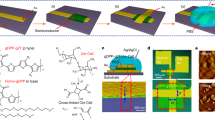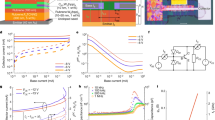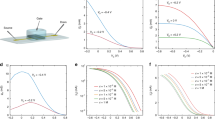Abstract
Organic electrochemical transistors (OECTs) can be used to create biosensors, wearable devices and neuromorphic systems. However, restrictions in the micro- and nanopatterning of organic semiconductors, as well as topological irregularities, often limit their use in monolithically integrated circuits. Here we show that the micropatterning of organic semiconductors by electron-beam exposure can be used to create high-density (up to around 7.2 million OECTs per cm2) and mechanically flexible vertical OECT arrays and circuits. The energetic electrons convert the semiconductor exposed area to an electronic insulator while retaining ionic conductivity and topological continuity with the redox-active unexposed areas essential for monolithic integration. The resulting p- and n-type vertical OECT active-matrix arrays exhibit transconductances of 0.08–1.7 S, transient times of less than 100 μs and stable switching properties of more than 100,000 cycles. We also fabricate vertically stacked complementary logic circuits, including NOT, NAND and NOR gates.
This is a preview of subscription content, access via your institution
Access options
Access Nature and 54 other Nature Portfolio journals
Get Nature+, our best-value online-access subscription
$29.99 / 30 days
cancel any time
Subscribe to this journal
Receive 12 digital issues and online access to articles
$119.00 per year
only $9.92 per issue
Buy this article
- Purchase on Springer Link
- Instant access to full article PDF
Prices may be subject to local taxes which are calculated during checkout






Similar content being viewed by others
Data availability
Source data are provided with this paper. Additional data related to this work are available from the corresponding authors upon request.
References
Chen, J. et al. Highly stretchable organic electrochemical transistors with strain-resistant performance. Nat. Mater. 21, 564–571 (2022).
Andersson Ersman, P. et al. All-printed large-scale integrated circuits based on organic electrochemical transistors. Nat. Commun. 10, 5053 (2019).
Park, S. et al. Self-powered ultra-flexible electronics via nano-grating-patterned organic photovoltaics. Nature 561, 516–521 (2018).
Stein, E. et al. Ambipolar blend-based organic electrochemical transistors and inverters. Nat. Commun. 13, 5548 (2022).
Rashid, R. B. et al. Ambipolar inverters based on cofacial vertical organic electrochemical transistor pairs for biosignal amplification. Sci. Adv. 7, eabh1055 (2021).
Picca, R. A. et al. Ultimately sensitive organic bioelectronic transistor sensors by materials and device structure design. Adv. Funct. Mater. 30, 1904513 (2020).
Torricelli, F. et al. Electrolyte-gated transistors for enhanced performance bioelectronics. Nat. Rev. Meth. Primers 1, 66 (2021).
Abarkan, M. et al. Vertical organic electrochemical transistors and electronics for low amplitude micro-organ signals. Adv. Sci. 9, 2105211 (2022).
Spyropoulos, G. D., Gelinas, J. N. & Khodagholy, D. Internal ion-gated organic electrochemical transistor: a building block for integrated bioelectronics. Sci. Adv. 5, eaau7378 (2020).
Harikesh, P. C. et al. Ion-tunable antiambipolarity in mixed ion–electron conducting polymers enables biorealistic organic electrochemical neurons. Nat. Mater. 22, 242–248 (2023).
Song, J. et al. 2D metal-organic frameworks for ultraflexible electrochemical transistors with high transconductance and fast response speeds. Sci. Adv. 9, eadd9627 (2023).
Wang, Y. et al. n-type organic electrochemical transistors with high transconductance and stability. Chem. Mater. 35, 405–415 (2023).
Rivnay, J. et al. Organic electrochemical transistors. Nat. Rev. Mater. 3, 17086 (2018).
Wu, X. et al. High performing solid-state organic electrochemical transistors enabled by glycolated polythiophene and ion-gel electrolyte with a wide operation temperature range from −50 to 110°C. Adv. Funct. Mater. 33, 2209354 (2023).
Cea, C. et al. Enhancement-mode ion-based transistor as a comprehensive interface and real-time processing unit for in vivo electrophysiology. Nat. Mater. 19, 679–686 (2020).
Khodagholy, D. et al. High transconductance organic electrochemical transistors. Nat. Commun. 4, 2133 (2013).
Schmatz, B., Lang, A. W. & Reynolds, J. R. Fully printed organic electrochemical transistors from green solvents. Adv. Funct. Mater. 29, 1905266 (2019).
Jiang, C., De Rijk, S. R., Malliaras, G. G. & Bance, M. L. Electrochemical impedance spectroscopy of human cochleas for modeling cochlear implant electrical stimulus spread. APL Mater. 8, 091102 (2020).
Koutsouras, D. A., Torricelli, F. & Blom, P. W. M. Submicron vertical channel organic electrochemical transistors with ultrahigh transconductance. Adv. Electron. Mater. 9, 2200868 (2023).
Kleemann, H., Krechan, K., Fischer, A. & Leo, K. A review of vertical organic transistors. Adv. Funct. Mater. 30, 1907113 (2020).
Huang, W. et al. Vertical organic electrochemical transistors for complementary circuits. Nature 613, 496–502 (2023).
Kim, J. et al. Scalable sub-micron patterning of organic materials toward high density soft electronics. Sci. Rep. 5, 14520 (2015).
Zheng, Y. Q. et al. Monolithic optical microlithography of high-density elastic circuits. Science 373, 88–94 (2021).
Wang, S. et al. Skin electronics from scalable fabrication of an intrinsically stretchable transistor array. Nature 555, 83–88 (2018).
Chortos, A. et al. Mechanically durable and highly stretchable transistors employing carbon nanotube semiconductor and electrodes. Adv. Mater. 28, 4441–4448 (2016).
Malinowski, P. E. et al. Photolithographic patterning of organic photodetectors with a non-fluorinated photoresist system. Org. Electron. 15, 2355–2359 (2014).
Chang, J. F., Gwinner, M. C., Caironi, M., Sakanoue, T. & Sirringhaus, H. Conjugated-polymer-based lateral heterostructures defined by high-resolution photolithography. Adv. Funct. Mater. 20, 2825–2832 (2010).
Gangnaik, A. S., Georgiev, Y. M. & Holmes, J. D. New generation electron beam resists: a review. Chem. Mater. 29, 1898–1917 (2017).
Qin, N. et al. Nanoscale probing of electron-regulated structural transitions in silk proteins by near-field IR imaging and nano-spectroscopy. Nat. Commun. 7, 13079 (2016).
Blanksby, S. J. & Ellison, G. B. Bond dissociation energies of organic molecules. Acc. Chem. Res. 36, 255–263 (2003).
Bässler, H. & Köhler, A. Charge transport in organic semiconductors. Top. Curr. Chem. 312, 1–65 (2012).
Liu, G. et al. Ultralow-power and multisensory artificial synapse based on electrolyte-gated vertical organic transistors. Adv. Funct. Mater. 32, 2200959 (2022).
Lenz, J., del Giudice, F., Geisenhof, F. R., Winterer, F. & Weitz, R. T. Vertical, electrolyte-gated organic transistors show continuous operation in the MA cm−2 regime and artificial synaptic behaviour. Nat. Nanotechnol. 14, 579–585 (2019).
Xie, Z. et al. All-solid-state vertical three-terminal N-type organic synaptic devices for neuromorphic computing. Adv. Funct. Mater. 32, 2107314 (2022).
Guo, E. et al. Vertical organic permeable dual-base transistors for logic circuits. Nat. Commun. 11, 4725 (2020).
Huggins, R. A. Simple method to determine electronic conductivity and ionic components of the conductors in mixed a review. Ionics 8, 300–313 (2002).
Wang, Y. et al. Hybrid alkyl-ethylene glycol side chains enhance substrate adhesion and operational stability in accumulation mode organic electrochemical transistors. Chem. Mater. 31, 9797–9806 (2019).
Wu, H. Y. et al. Influence of molecular weight on the organic electrochemical transistor performance of ladder-type conjugated polymers. Adv. Mater. 34, 2106235 (2022).
Ohayon, D. et al. Influence of side chains on the n-type organic electrochemical transistor performance. ACS Appl. Mater. Interfaces 13, 4253–4266 (2021).
Giovannitti, A. et al. N-type organic electrochemical transistors with stability in water. Nat. Commun. 7, 13066 (2016).
Yan, Y. et al. High-performance organic electrochemical transistors with nanoscale channel length and their application to artificial synapse. ACS Appl. Mater. Interfaces 12, 49915–49925 (2020).
Savva, A. et al. Solvent engineering for high-performance n-type organic electrochemical transistors. Adv. Electron. Mater. 5, 1900249 (2019).
Wu, X. et al. Universal spray-deposition process for scalable, high-performance, and stable organic electrochemical transistors. ACS Appl. Mater. Interfaces 12, 20757–20764 (2020).
Moser, M. et al. Side chain redistribution as a strategy to boost organic electrochemical transistor performance and stability. Adv. Mater. 32, 2002748 (2020).
Chércoles Asensio, R., San Andrés Moya, M., De La Roja, J. M. & Gómez, M. Analytical characterization of polymers used in conservation and restoration by ATR-FTIR spectroscopy. Anal. Bioanal. Chem. 395, 2081–2096 (2009).
Kim, J. et al. Vertically stacked full color quantum dots phototransistor arrays for high-resolution and enhanced color-selective imaging. Adv. Mater. 34, 2106215 (2022).
Lee, W. et al. Transparent, conformable, active multielectrode array using organic electrochemical transistors. Proc. Natl Acad. Sci. USA 114, 10554–10559 (2017).
Lee, W. et al. Nonthrombogenic, stretchable, active multielectrode array for electroanatomical mapping. Sci. Adv. 4, eaau2426 (2018).
Weissbach, A. et al. Photopatternable solid electrolyte for integrable organic electrochemical transistors: Operation and hysteresis. J. Mater. Chem. C. 10, 2656–2662 (2022).
Kang, J. et al. Symmetrically ion-gated in-plane metal-oxide transistors for highly sensitive and low-voltage driven bioelectronics. Adv. Sci. 9, 2103275 (2022).
Koutsouras, D. A., Torricelli, F., Gkoupidenis, P. & Blom, P. W. M. Efficient gating of organic electrochemical transistors with in-plane gate electrodes. Adv. Mater. Technol. 6, 2100732 (2021).
Rivnay, J. et al. Organic electrochemical transistors with maximum transconductance at zero gate bias. Adv. Mater. 25, 7010–7014 (2013).
Song, C. K., Eckstein, B. J., Tam, T. L. D., Trahey, L. & Marks, T. J. Conjugated polymer energy level shifts in lithium-ion battery electrolytes. ACS Appl. Mater. Interfaces 6, 19347–19354 (2014).
Wang, Z. et al. Cinnamate-functionalized natural carbohydrates as photopatternable gate dielectrics for organic transistors. Chem. Mater. 31, 7608–7617 (2019).
Kostianovskii, V., Sanyoto, B. & Noh, Y. Y. A facile way to pattern PEDOT:PSS film as an electrode for organic devices. Org. Electron. 44, 99–105 (2017).
Acknowledgements
This work was supported by the AFOSR (contract no. FA9550-22-1-0423), the US Office of Naval Research Contract no. N00014-20-1-2116, by the US Department of Commerce, National Institute of Standards and Technology as part of the Centre for Hierarchical Materials Design Award no. 70NANB10H005, BSF (award no. 2020384), NSF (DMR-2223922) and the Northwestern University Materials Research Science and Engineering Center Awards NSF DMR-1720139 and DMR-2308691. J.R. gratefully acknowledges support from the Alfred P. Sloan Foundation (FG-2019-12046). This work acknowledges the US Department of Energy under contract no. DE-AC02-05CH11231 at beamline 8-ID-E of the Advanced Photon Source, a US Department of Energy (DOE) Office of Science User Facility operated for the DOE Office of Science by Argonne National Laboratory under Contract No. DE-AC02-06CH11357. This work made use of the NUFAB facility of Northwestern University’s NUANCE Center, which has received support from the SHyNE Resource (NSF ECCS-2025633), the IIN and Northwestern’s MRSEC programme (NSF DMR-1720139).
Author information
Authors and Affiliations
Contributions
J.K., T.J.M. and A.F. conceived and designed the research. J.K. carried out the device fabrication, characterizations and demonstrations. R.M.P. and Y.C. synthesized the polymer semiconductors. J.K., R.M.P., I.D.D., F.Q., D.Z. and W.H. analysed the data. D.M., R.D. and J.R. conducted the bandwidth and EIS measurements. R.M.P. and I.D.D. measured and analysed the GIWAXS. All the authors discussed the results and commented on the manuscript. J.K., J.R., T.J.M. and A.F. wrote the manuscript.
Corresponding authors
Ethics declarations
Competing interests
A patent application has been filed by Northwestern with inventors J.K., T.J.M. and A.F. The remaining authors declare no competing interests.
Peer review
Peer review information
Nature Electronics thanks Wei Lin Leong and the other, anonymous, reviewer(s) for their contribution to the peer review of this work.
Additional information
Publisher’s note Springer Nature remains neutral with regard to jurisdictional claims in published maps and institutional affiliations.
Supplementary information
Supplementary Information
Supplementary Figs. 1–19 and Tables 1–6.
Supplementary Tables 1–6
Supplementary Tables 1–6.
Source data
Source Data Fig. 1
Statistical Source Data.
Source Data Fig. 2
Statistical Source Data.
Source Data Fig. 3
Statistical Source Data.
Source Data Fig. 4
Statistical Source Data.
Source Data Fig. 5
Statistical Source Data.
Source Data Fig. 6
Statistical Source Data.
Rights and permissions
Springer Nature or its licensor (e.g. a society or other partner) holds exclusive rights to this article under a publishing agreement with the author(s) or other rightsholder(s); author self-archiving of the accepted manuscript version of this article is solely governed by the terms of such publishing agreement and applicable law.
About this article
Cite this article
Kim, J., Pankow, R.M., Cho, Y. et al. Monolithically integrated high-density vertical organic electrochemical transistor arrays and complementary circuits. Nat Electron 7, 234–243 (2024). https://doi.org/10.1038/s41928-024-01127-x
Received:
Accepted:
Published:
Issue Date:
DOI: https://doi.org/10.1038/s41928-024-01127-x
This article is cited by
-
A new path for organic electrochemical transistors
Nature Reviews Electrical Engineering (2024)



